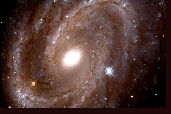Tophat and a Very Long Tail
by Duane Dunkerson
Before there were stars and galaxies there was the
cosmic microwave background radiation (CMBR). Tophat, a
name for a unit of experimental apparatus, sits atop a
high-altitude (120,000 ft.) balloon. It must be placed
high in the sky above most of our interfering
atmosphere. Tophat may fly for days or weeks. As it goes
along it spins and "sees" a circle in the sky above the
South Polar Region. It is carried along above the South
Pole because at the Pole there are conditions supportive
of less interference for the measurements. The air is
dry since there is less water vapor, warm objects giving
off radiation aren't as prevalent, and the Sun's own
microwave radiation is lessened by being no more than 23
degrees above the horizon during the 6 month "day" and
not seen for the 6 month "night".
What Tophat has at its crux are bolometers. The
bolometers are detectors that sense heat. Tophat's
detectors are extremely sensitive. In the circle that it
is seeing, Tophat is to record variation in the CMBR
intensity in its circle in the sky. It is known that the
CMBR is not spread out evenly in the sky.
Concentrations, however slight, have been found. Tophat
has a phenomenal accuracy that enables astronomers to
find out to what degree the concentrations vary.
The universe, in its beginning, was hot and CMBR is the
what's left behind like the warmth near you after the
wood-burning stove's fire has gone out. In this case the
stove (the universe) has expanded. The stove's logs were
not placed evenly one apart from the other. They
overlapped. The radiation, their warmth, is not evenly
distributed away from the stove.
Once the stars and galaxies came along, they did so in
correlation with where the radiation varied in
distribution. The stars and galaxies have their own
distribution now as we see them. The CMBR is older than
the stars and galaxies. We can see differing times in
the universe - CMBR time and star-galaxy time. Noting
the distribution of CMBR as compared to the distribution
of the stars and galaxies, one can infer the age, size,
and mass of the universe. Other fundamental questions
about the universe can be addressed such as will the
universe expand forever?
We can't find out the answers as quickly as we might
like. Tophat and its balloons can go up only once a year
during favorable weather conditions. Our slow data
gathering is puny in time span against the billions of
years we use to characterize the universe. Yet we may in
a short time be able to speak confidently of scientific
matters in relation to a time scale far beyond our
limits.

